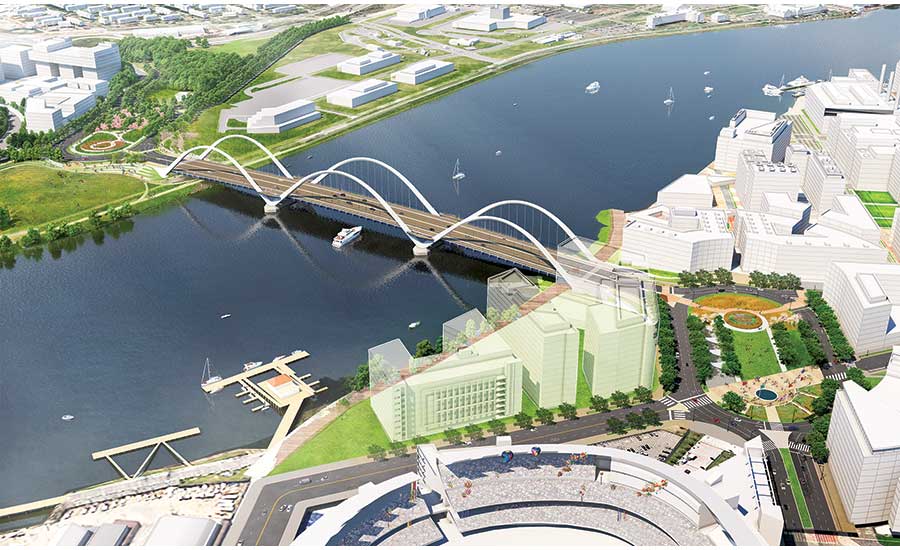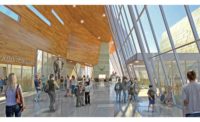In 1988, when geotechnical engineer Henry Lucas formed Engineering Consulting Services inside a Chantilly, Va., construction-site trailer, the firm’s managers designated its first job—a mixed-use development in Washington, D.C.—as project number 1,000. That numerical jump-start, Lucas explains, was meant to illustrate that though the firm was brand new, its 11-person staff had extensive experience with geotechnical testing, analysis and design.
Three decades and about 600,000 projects later, such steps to boost the firm’s profile are no longer necessary. ECS is firmly established as a leading geotechnical and environmental design firm in its home region, and beyond.
The gains continued last year, as the firm’s MidAtlantic division recorded $91.6 million in regional revenue, up 6% from 2016. The firm ranks 17th on the ENR MidAtlantic Top Design Firm list, compared with No. 14 last year. ECS’s total revenue of $203.1 million placed it 75th among ENR’s Top 500 Design Firms this year. The firm ranked 81st on the 2017 Top 500.
Beyond its increased revenue, ECS has been an early adopter of innovations such as electronic field reports and has given back to the communities where it works. The firm has a new program called Promoting All Women’s Strengths in the MidAtlantic area to help women leaders grow and share ideas. ECS offices sponsor events and support causes close to where employees live and work, including the Avon Walk to End Breast Cancer, the Kindergarten STEM program and the Builders Foundation, a nonprofit organization dedicated to assisting children and families who may need special help.
These are some of the reasons why ENR MidAtlantic has named the company its Design Firm of the Year.
“[ECS knows] what it takes to get permits and projects through, even if there are tough issues to address.”
– John Fitzpatrick, Vice President for Project Management, Regency Centers
From that jobsite trailer 30 years ago, ECS has expanded to more than 60 offices. Much of the growth has been in its existing markets. But ECS also has stretched its horizon westward, with San Antonio and Oklahoma City among the latest new locations. ECS has also made occasional strategic acquisitions. Its latest deals include acquiring River Valley Testing Corp., in central Wisconsin, last December and Louisville-based GEM Engineering Inc. earlier this year.
Lucas, ECS’s president, says one benefit from expansion is that it “creates opportunities for younger employees, so they’ll want to stay with us.”
Even as ECS has extended its geographical presence, it continues to win a steady stream of design work close to home. Leo Titus, a 21-year ECS employee who heads the firm’s MidAtlantic subsidiary, says the company’s success is a credit to its ability to diversify from its commercial office and residential roots into other sectors.
For example, ECS’s design- and construction-phase geotechnical services on the I-495 Capital Beltway Express Lanes in northern Virginia provided the entrée for participating in other major transportation projects. Among them are design-phase geotechnical services and construction support for the $2.6-billion, 16-mile Purple Line light rail project in Washington’s Maryland suburbs and the $1-billion South Capitol Street Corridor in the District of Columbia, which will include a replacement for the Frederick Douglass Bridge over the Anacostia River.
Still, Titus says, “Our foundation has always been the private sector, but even then, the clientele differs from Philadelphia to Baltimore and D.C., and then down to Richmond.”
Taking on complex, high-profile efforts such as the Purple Line, Titus adds, benefits ECS well beyond just the company’s bottom line.
“Because of its size, the Purple Line would have been difficult for just one office to handle,” he explains. With 11 ECS MidAtlantic offices having contributed to the project so far, Titus says, “it’s a great opportunity for our engineers to work on a big project and to share skills and resources.”
ECS has also augmented its core geotechnical focus with other services such as facilities inspections, permitting assistance, environmental site assessments, construction monitoring and materials testing.
“They know what it takes to get permits and projects through, even if there are tough issues to address,” says John Fitzpatrick, vice president for project management with Vienna, Va.-based Regency Centers, which develops and operates more than 400 retail centers across the U.S. An ECS client for 19 years for new construction and renovations, Fitzpatrick adds that ECS’s well-structured, thorough and concise reporting “is the best there is. They get the program, and it helps us with making decisions.”
Modernizing methods
Another differentiator has been ECS’s corporate-wide embrace of new technology. In the 1990s, Lucas was an early proponent of putting field reports into an electronic format to share via email with contractors and owners. He also encouraged the use of pressure meters to test soils for making strength and stability calculations, providing greater accuracy compared with conventional standard penetration tests (SPTs).
“That helped us build a region-wide database with soil properties which, in turn, helps us understand how they’ll behave for various foundation options,” explains Michael Rayl, a senior project engineer and head of ECS’s special projects group, which focuses primarily on infrastructure work. He adds, “Knowing what to expect results in less-conservative foundation designs that can help reduce project costs.”
Taking advantage of these and other technology tools has proven valuable given how many projects are located in dense urban areas, such as the South Capitol Street Corridor, says Rayl.
“We’re working around fragile sewer infrastructure that dates back to the late 1800s,” he says. “With little information about their condition or even what they’re made up of, we have to be prepared with a variety of protection and foundation plans. And with so many stakeholders involved in these projects, communication as new data arrives and designs are refined is critical.”
Lucas says that while ECS has always tried to be forward-thinking, having a well-trained staff has been the biggest factor distinguishing it from competitors. .
“We’ve invested a lot in encouraging [employees] to pursue master’s degrees and add to their skills,” he says. That includes in-house training in project management and leadership skills that help workers prepare for future promotions or another “head start” into a new market. “It we’re looking to open a new office somewhere, we likely have employees originally from that area who are interested in going back and helping it get started,” Lucas says, adding that the MidAtlantic market still has a promising outlook.
“For the most part, things are the same now as they were when we started, [but] data centers have given the region an industrial component it didn’t have, and we see a lot of potential there,” he says.
Titus agrees, even though he admits the region’s current 10-year economic growth trend could become frayed at some point. “Getting through the Great Recession wasn’t fun, but we remained profitable and came out of it with a team of veterans managing our offices,” he says. “They know what to look for.”
Looking ahead, Titus offers a reminder that infrastructure, high-rises and other projects are, fundamentally, alike. “They all use the same steel and concrete and soil,” he says. “It’s just a matter of knowing what owners want to build and how we can help them do it.”
ECS’s High-Profile Regional Work Includes:
The South Capitol Street Corridor
The $441-million bridge is Washington, D.C.’s largest publicly funded construction project. It aims to improve traffic flow, provide dedicated lanes and crossings for pedestrians and cyclists and increase access to the Anacostia riverfront. Drainage and stormwater-management improvements and new public event spaces are also parts of the project, which is slated for completion in 2021.
Purple Line
After years of controversy and repeated delays, the 16-mile light rail system connecting Bethesda and New Carrollton in Maryland finally broke ground last August. ECS is providing design-phase geotechnical services and construction support for the entire route, which will include two short tunnels and connections with existing Metrorail stations.
Prince George’s Regional Medical Center
The 600,000-sq-ft, $543-million hospital will provide Prince George’s County, Md., residents with a cancer center, stroke center, 45-bay emergency department and a self-contained pediatric hospital. ECS is providing geotechnical and construction-materials testing across the entire 26-acre site. The project is scheduled to open in early 2021.
One Light Street
Baltimore’s newest high-rise is a 28-story, mixed-use tower combining luxury apartments, nine floors of virtually column-free office space and 5,000 sq ft of retail space. The $160-million project is scheduled for completion in December 2018.





Post a comment to this article
Report Abusive Comment